
In August, Porter Cable announced a new line of 12 Volt MAX lithium ion, cordless power tools. These tools are compact and lightweight with the quality professionals demand. There are 4 tools in this line: a 3/8″ Drill/Driver (PCL120DDC-2), a 1/4″ Impact Driver (PCL120IDC-2), a Two-Tool Kit (PCL212IDC-2) and a ClampSaw™ Kit (PCL120CRC-2). They are designed to tackle the most common drilling, fastening, and cutting applications in small workspaces. Porter Cable was kind enough to provide several tools as part of a test kit, so stay tuned for more reviews.
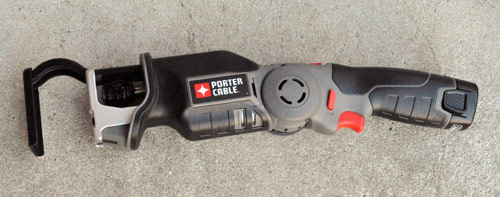
Porter Cable Cordless ClampSaw (PCL120CRC-2)
Today’s post focuses on the Porter Cable ClampSaw, styled after a reciprocating saw but much more compact. Plus, it’s equipped with an adjustable clamping shoe.
The Good: Compact; pivoting handle; clamp shoe; variable speed trigger; 2 batteries included
The Bad: Allen key to adjust clamp shoe
Overall: A great tool for making on-site cuts; cutting small stock materials
Pivoting Handle
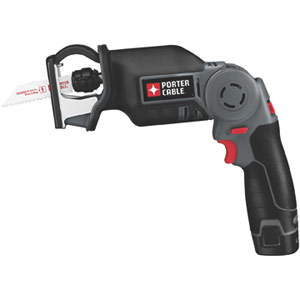 The ClampSaw is small and compact, perfect for working in tight spaces, and the pivoting handle features three-positions for maximum versatility. Rotate between 0°, 45° and 90° by engaging the pivot release and sliding the handle until it locks.
The ClampSaw is small and compact, perfect for working in tight spaces, and the pivoting handle features three-positions for maximum versatility. Rotate between 0°, 45° and 90° by engaging the pivot release and sliding the handle until it locks.
Styling and Ergonomics
Porter Cable made the ClampSaw to fit right into your hand. The trigger, pivot release, and lock-off switch are all placed for easy, one-handed operation. There’s a comfortable rubber grip on the handle and around the motor housing for your support hand; however, this saw weighs less than 3 pounds making it easy to use one handed.
Clamp Shoe
The ClampSaw is named for the clamp shoe that helps lock materials in place and reduce work piece vibrations. You are able to adjust the shoe using the included Allen Key, accommodating 2″ stock or smaller. This is a real advantage for making repetitive, on-site cuts, like a plumber cutting copper pipe or an electrician cutting conduit.
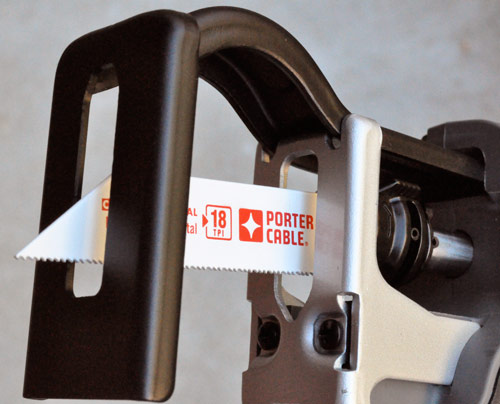
Blade Changes
I’m a big fan of tools that make it easy to change blades and Porter Cable delivers. Rotate the blade clamp collar to release the blade. Make sure to fully insert the blade shank and release the collar. Blades can be inserted teeth up or down depending on application. Be careful as used blades can be hot.
Cutting
Porter Cable included a variable speed trigger allowing you greater control, delivering up to 3,000 strokes per minute and a 5/8″ stroke length. It’s designed to cut medium-duty wood, metal, PVC, copper pipe, threaded rod, and more. The ClampSaw performed admirably on my test materials- 1″ copper pipe and rugged plastic. The hinged body and clamp shoe also make one-handed cuts much easier. I also want to mention the integrated LED that activates with the trigger.
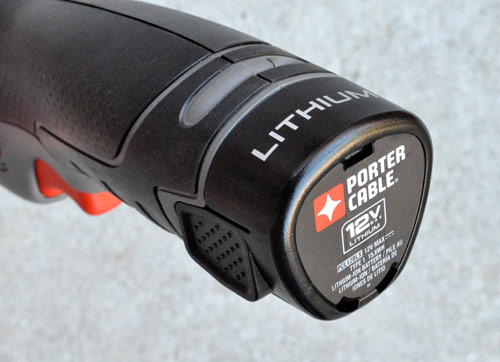
Battery & Charger
The entire line of 12v MAX tools is equipped with 12v lithium ion batteries, holding charge for extended periods of time. I love that Porter Cable included two batteries! That means you can have one in the charger as a backup. Batteries recharge in 30 minutes in the included charger.
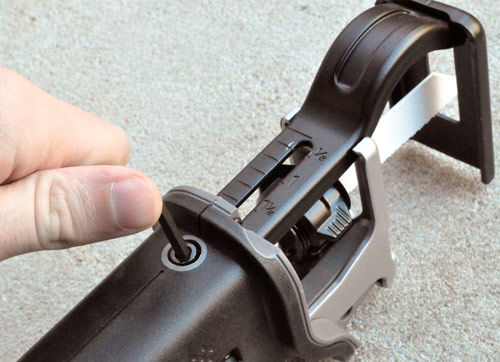
Price and Where to Buy
The entire 12v MAX line just became available in October 2010. Look for them at Lowe’s and through the independent channel with a suggested retail price of $129.00. Here’s what included with the ClampSaw kit:
- Porter Cable ClampSaw (PCL120CRC-2)
- (2) 12 volt lithium ion batteries (PCL12BLX)
- Battery charger (PCL12C)
- (1) 4-inch wood cutting blade and (1) 4-inch inch metal cutting blade
- Side-sided storage bag
ClampSaw Specifications
- Voltage: 12V Max
- Strokes/Min: 0-3,000 spm
- Stroke Length: 5/8″
- Length: 9.5″
- Width: 2 1/4″
- Height: 3.4″
- Weight: 3.4 lbs w/Battery
What do you think? How would you put the ClampSaw to good use?







This is a silly tool. The swivel ‘feature’ just looks like it is begging to collapse. Sort of like those three position utility knives that if you apply any pressure, jump the stops and cause problems.
Anytime you need to use one of the heavy duty recip. saws, you are working in an area that requires control that comes from a fixed tool such as a ‘sawsall’ type, this tool just looks like it will cause problems.
WTF is the deal with a “Depth guide”? Recip. saws are not plunge cutting tools in any shape or form. With that ‘guide’ extended, it will probably take only one drop on its nose and then it is off to the repair shop.
The ‘clamping feature’ for cutting pipe is iffy especially if you need to carry around an allen wrench which according to your post is not provided. No electrician or plumber is gonna use this thing for cutting pipe. The time needed to remove the burrs for tight joints in either plumbing or electric conduit work makes this a non starter.
Even being able to reverse the blade, the saw is so bulky that cutting a existing floor plate out of the way looks like it will just bend or break blades.
This is not a serious tool for remodeling or woodworking. Maybe for pumpkin carving.
Hey alan,
The swivel feature seemed very sturdy to me, locking securely in place. I doubt it will jump at all.
I wouldn’t use this to replace a heavy-duty sawsall but it can make a variety of cuts (including plunge). The reversible blade gives you several different options. The ClampSaw is designed for light- medium duty applications.
The clamping feature isn’t a true “clamp”. It’s designed for one-handed cutting and reducing vibration. The Allen key is included (as stated in the post).
You can see the weight and dimensions listed- do you really think it’s that bulky?
Alan – I’ve tested this tool as well and it’s actually a decent tool if you cut pipe. For plumbers and electricians it’s perfect for cutting repetitive pipe sizes. Let’s say you cut conduit all day or 3/4″ copper pipe, pretty simple with this saw.
DIY and homeowners….not really much use in my opinion.
Lastly…it’s a pretty rugged tool and not at all flimsy.
Next time you’re at the tool store pick one up and test it out…you’ll see what I mean.
Ethan,
I stand corrected on the allen wrench, but there is another piece of stuff to carry around to use a tool. Very light applications. This is not the type of tool to recommend to a DIY’er, Yes, bulky in terms of dimension and not weight, when looking at the distance from the motor case to the cutting edge. How many times do you get to cut in the middle of anything?
One handed? The type of work that will be attempted will cause this tool to jump increasing the danger of injury to the user. Just it says that you should a 4” blade, folks will see much longer blades that fit, and there you go. This is a classic ”having a hammer and everything looks like a nail”.
Todd,
This is not a DIY tool in any sense. As I mentioned earlier, I do not see this as a pipe cutting tool either.
On copper from any saw, this or recip saws will leave burrs that have to be removed. On the exterior to get a smooth surface for sweat connections. On the interior to eliminate water tumbling,where a burr inside causes water to blast holes in elbows causing leaks in supply line plumbing.(I had this happen to me in my house)
PVC on the drain side has similar issues, Outside for glue joints., Inside to prevent buildup of waste materials in drains.
On conduit, the burr issue rears up on leaving a burr inside to cut conductor insulation leading to shorts and or electrical fires. On exterior conduit burrs will defeat water tight couplings.
This may sound a little picky, but unless you do this for a living which most DIY’ers be definition do not, it is the little things that will bite them in the butt. Like removing burrs from pipe and conduit before making connections:)
Pipe and tubing cutters have remained the same for years because they work.
This tool is aimed at the DIY market, but is not in my opinion the tool for a homeowner to spend their money on.
This Dewalt Recip saw is a better tool. The shoe needs no tool for adjustment, the blade can be mounted in 4 positions. Yes it is more money, but better spent.
DeWALT DC385K 18-Volt Ni-Cad Cordless Reciprocating Saw Kit
Alan – I’m going to agree to disagree with you. I actually brought this tool to two of my job sites and let the plumbers and electricians play around with it. They all said it was more convenient that trying to use their regular recip saw for cutting pipe.
You’re correct about the burs but this will ultimately be used for cutting material to rough lengths, same thing they would use the recip saw for.
I just think you’re missing the point on this one. It’s not being marketed to DIY’ers at all.
Just my 2 cents.
This looks like a handier version of a heavier recip saw to me, and I like that it pivots.